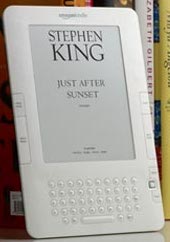Kindle 2 ships — with Linux inside
Mar 6, 2009 — by Eric Brown — from the LinuxDevices Archive — 5 views [Updated: Mar. 9, 2009] — Amazon.com has published the source code for its now-shipping, second-generation eBook reader. Compared to the original, the smaller Kindle 2 adds battery life, grayscale shades, internal storage, and processor power, while omitting SD memory expansion.
[Updated: Mar. 9, 2009] — Amazon.com has published the source code for its now-shipping, second-generation eBook reader. Compared to the original, the smaller Kindle 2 adds battery life, grayscale shades, internal storage, and processor power, while omitting SD memory expansion.
(Click for larger view of the Kindle 2)
On Feb. 9, Amazon announced the Kindle 2 to much fanfare and critical acclaim, as well as criticism over the high $360 price-tag. Over the last year, the original 3G-enabled Kindle has been one of the hottest selling consumer electronics devices around, leading to shortages this holiday season.

Kindle 2
The Kindle 2 appears to have moved up to a second-generation E Ink screen. The display has the same size and resolution, but moves from four shades of gray to 16, resulting in crisper text and images, claims Amazon. Amazon claims that pages turn an average of 20 percent faster than the original Kindle, too.
The Kindle 2 is thinner than the Kindle 1, measuring 8 x 5.3 x 0.36 inches, and it now weighs only 10 ounces. The device offers new buttons for easier page turning, and a new five-way controller that enables easier note-taking and page jumps, as well as the ability to highlight up, down, and to both sides, claims Amazon.

The Kindle 2 offers a new dictionary feature
The Kindle 2 adds processing power, too, stepping up to an ARM11-based Freescale i.MX31 system-on-chip (SoC) clocked to 532MHz (the Kindle 1 used a PXA250).
The Kindle 2 has 32MB of RAM, and 2GB of internal storage. User-available storage is listed as 1.4GB — enough for about 1,500 books, Amazon claims. The original Kindle stored only about 200 books internally, but had an SD card slot for infinite expandability.
Battery life is claimed to be 25 percent longer, running four to five days on one charge with wireless enabled, and over two weeks when disabled. Like the Kindle 1, the device includes an EVDO 3G modem hooked up with free access to Amazon's Whispernet service, which is based on Sprint's 3G data network, and now expanded to cover all 50 U.S. states.
Other features include a mini-USB 2.0 connector (which can charge the Kindle 2), as well as a 3.5mm stereo audio jack and rear-mounted stereo speakers.
 Stephen King wrote an ebook especially for the Kindle 2 |
Additional new features include a new text-to-speech “read-to-me” feature, which lets users switch back and forth between reading and listening. A New Oxford American Dictionary is also available (pictured above). As before, the Kindle offers an MP3 player and a web browser, and supports a wide variety of text and image files.
Still Linux after all these months
As mandated by the GPL, Amazon duly published an open-source download page when it began distributing the Kindle 2. The page includes the GPL'd Linux sources, sans .config files, for both the Kindle 1 and Kindle 2. The Kindle 2's stack appears to be based on a Linux 2.6.22 kernel, along with U-Boot, Alsa, Busybox, and various other popular open source software programs.
According to renowned Linux kernel hacker Robert Love, who evaluated the original Kindle distribution in November 2007 (soon after, the Kindle was promptly hacked), the Kindle 1 was based on an Marvell PXA250 processor. He also found it ran a power-saving infrastructure named fpow, which provides device-level power management and aggressive system suspend functionality for improving battery life. The new Kindle 2 appears to use Intel's new Powertop fast-boot technology.
Linux eBook background
The Kindle was clearly the first breakthrough ebook reader. Aside from having the advantage of linking to Amazon's huge media collection (the Kindle Store now offers over 230,000 books), one of its chief appeals was that it was the first commercial ebook reader to adopt low-power “electronic paper” display technology sourced from E Ink. Since the Kindle debuted, a number of other ebook readers have appeared, most of them similarly Linux-based, and almost all of them using the same 6-inch, 800×600 gray-scale E-Ink displays.



Hanlin eReader, Bookeen Cybook and Foxit eSlick (l),
(Click any for details)
Most of the competing ebook readers are also Linux-based, including the Hanlin eReader V3, the Bookeen Cybook, and the recent Foxit eSlick which appears to have considerable momentum behind it in the U.S.
E Ink says its technology has appeared in a variety of watches and other consumer electronic products from Seiko, Citizen, and Microsoft. It is also used in Sony's LibriE e-book, which is available in Japan. Other Linux ebook readers that use E Ink e-paper include the Readius, eRead Star eBook STK-101, and the original iRex iLiad.
More details about the Kindle 2's internals can be found in an Ifixit.com story, here.
Availability
The Kindle 2 is available now for $360, here, says Amazon.
This article was originally published on LinuxDevices.com and has been donated to the open source community by QuinStreet Inc. Please visit LinuxToday.com for up-to-date news and articles about Linux and open source.